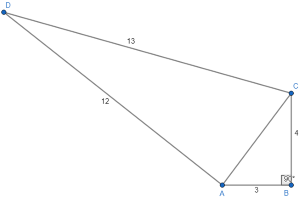I think I can answer #1

The diagram below meets all the given criteria. It is a quadrilateral with the given side lengths. Since \(\overline{AC}\) is the hypotenuse of \(\triangle ABC\), we can use the Pythagorean Theorem to find the length of the missing side length. Of course, this triangle satisfies the most famous pythagorean triple, a 3-4-5 right triangle, so \(AC=5\).
Yet again, \(\triangle DAC\) is in a similar situation. It is a 5-12-13 triangle, which is another Pythagorean triple. Because of this, \(m\angle DAC=90^\circ\).
I can break up the area of the original quadrilateral into two smaller parts: the 3-4-5 right triangle and the 5-12-13 right triangle.
Using the formula \(A_{\triangle}=\frac{1}{2}bh\), one can identify the areas of both triangles. This process is even simpler since the height of both triangles is also the perpendicular height.
| \(A_1=\frac{1}{2}*3*4\\ A_1=2*3\\ A_1=6\) | \(A_2=\frac{1}{2}*5*12\\ A_2=6*5\\ A_2=30\) |
Now, just add the areas together.
\(A_1+A_2=A_{\text{total}}\\ 6+30=36\text{units}^2\)
Many of the questions seem to suggest that there is a complementary diagram or some missing information (2, 3, 5 and 6)
.The problem says that y = 8x + 17 .
To find y when x = 0 , plug in 0 for x and solve for y .
When x = 0 , y = 8(0) + 17 = 0 + 17 = 17
When x = 1 , y = 8(1) + 17 = 8 + 17 = 25
When x = 2 , y = 8(2) + 17 = 16 + 17 = 33
When x = 3 , y = 8(3) + 17 = ...can you finish this?
And this is how to fill in the table...
| _x (number of years renewed)__ | 0 | 1 | 2 | 3 | 4 |
| _y (total cost in dollars) | _17_ | _25_ | _33_ | ____ | ____ |
Can you finish the last two?